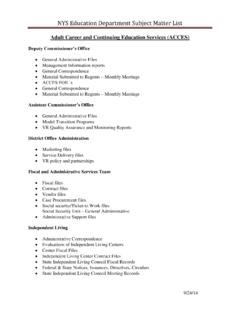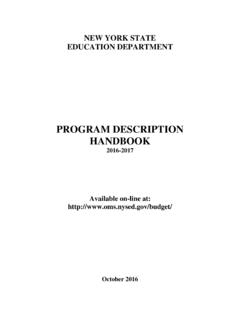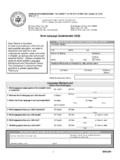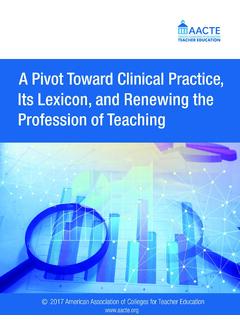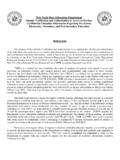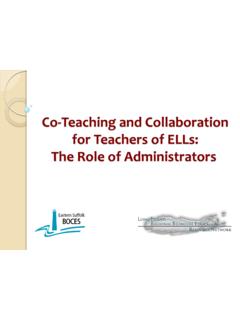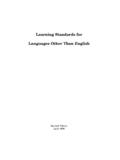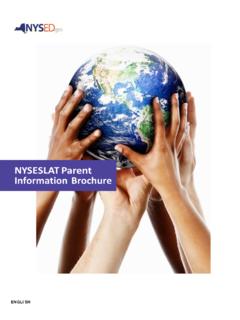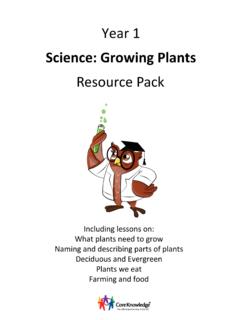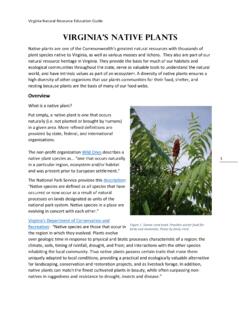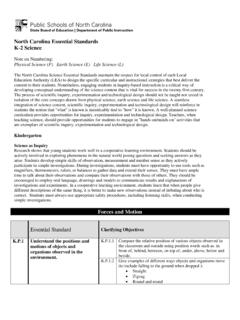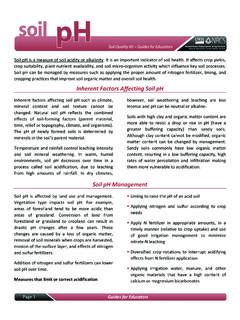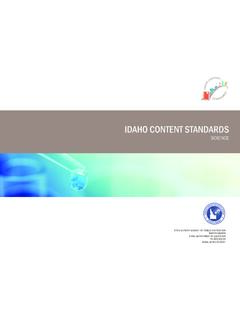Transcription of New York State P-12 Science Learning Standards
1 New York State P-12 Science Learning Standards *The performance expectations marked with an asterisk integrate traditional Science content with engineering through a Practice or Disciplinary Core Idea. The text in the Disciplinary Core Ideas section is reproduced verbatim from A Framework for K-12 Science Education: Practices, Cross-Cutting Concepts, and Core Ideas unless it is preceded by (NYSED). Page1 P. Physical sciences Students who demonstrate understanding can: P- PS1-1. Ask questions and use observations to test the claim that different kinds of matter exist as either solid or liquid. [Clarification Statement: Emphasis should be on observing and describing similarities and differences between solids and liquids based on theirphysical properties. Solids and liquids can be compared and categorized (sorted) based on those properties.] P- PS2-1. Use tools and materials to design and build a device that causes an object to move faster with a push or a pull.
2 * [Clarification Statement: Emphasis should be on developing an interest in investigating forces (pushes or pulls). Examples of forces could include astring attached t o an object being pulled or a ramp to increase the speed of an object.] [Assessment Boundary: Assessment is limited to relative measures of speed (slower, faster)] P- PS4-1. Plan and conduct investigations to provide evidence that sound is produced by vibrating materials. [Clarification S tatement: Examples of vibrating materials could include percussion instruments ( drum, triangle), string instruments ( guitar, piano), wind instruments ( r ecorder, whistle), and audio speakers.] The performance expectations above were developed using the following elements from the NRC document A Framework for K-12 Science Education Science and Engineering Practices Asking Questions and Defining Problems Asking questions and defining problems in grades PK 2 builds on prior experiences and progresses to simple descriptive questions that can be tested.
3 Ask questions based on observations to find moreinformation about the designed world. (P-PS1-1) Planning and Carrying Out Investigations Planning and carrying out investigations to answer questions or test solutions to problems in PK 2 builds on prior experiences and progresses to simple investigations, based on fair tests, which provide data to support explanations or design solutions. With guidance, plan and conduct an investigation incollaboration with peers. (P -PS2-1),(P-PS4-1) Analyzing and Interpreting Data Analyzing data in PK 2 builds on prior experiences and progresses to collecting, recording, and sharing observations. Record information (observations, thoughts, and ideas).(P -PS1-1) Analyze data from tests of an object or tool to determineif it works as intended. (P -PS2-1) ---------------------------------------- ------------- Connections to Nature of Science Scientific Investigations Use a Variety of Methods Scientists use different ways to study the world.
4 (P-PS2-1),(P-PS4-1) Disciplinary Core Ideas : Structure and Properties of Matter (NYSED) Different kinds of matter exist and many of them can beeither solid or liquid. Matter can be described, categorized, and sorted by its observable properties. (P -PS1-1) : Forces and Motion Pushes and pulls can have different strengths and directions. (P -PS2-1) Pushing or pulling on an object can change the speed or directionof its motion and can start or stop it. (P-PS2-1) : Relationship Between Energy and Forces (NYSED) A push or a pull may cause stationary objects to move, anda stronger push or pull in the same or opposite direction makes an object in motion speed up or slow down more quickly. (secondary to P- PS2-1) : Wave Properties Sound can make matter vibrate, and vibrating matter can makesound. (P-PS4-1) : Defining Engineering Problems A situation that people want to change or create can beapproached as a problem to be solved through engineering.
5 Such problems may have many acceptable solutions. (P -PS2-1) Crosscutting Concepts Patterns Patterns in the natural andhuman designed world can be observed and used as evidence. (P -PS1-1),(P-PS4-1) Cause and Effect Simple tests can be designed togather evidence to support or refute student ideas about causes. (P-PS2-1),(P-PS4-1) Connections to other DCIs in prekindergarten: (P-PS2-1); (P-PS4-1) Articulation of DCIs across grades K-1: (P-PS1-1); (P-PS2-1); (P-PS2-1); (P-PS2-1); (P-PS4-1) New York State Next Generation Learning Standards Connections: ELA/Literacy PKR1 Participate in discussions about a text. (P-PS1-1),(P-PS2-1),(P-PS4-1) PKR4 Exhibit an interest in Learning new vocabulary. (P-PS1-1),(P-PS2-1),(P-PS4-1) PKW2 Use a combination of drawing, dictating, oral expression, and/or emergent writing to name a familiar topic and supply information in child-centered, authentic, play-based Learning . (P-PS1-1),(P-PS2-1),(P-PS4-1) PKW3 Use a combination of drawing, dictating, oral expression, and/or emergent writing to narrate an event or events in a sequence.
6 (P-PS1-1),(P-PS2-1),(P-PS4-1) PKW7 Engage in a discussion using gathered information from experiences or provided resources. (P-PS1-1),(P-PS2-1),(P-PS4-1) PKSL2 Interact with diverse formats and texts. (P-PS1-1),(P-PS2-1),(P-PS4-1) PKSL3 Identify the speaker. (P-PS1-1),(P-PS2-1),(P-PS4-1) PKSL5 Create a visual display. (P-PS1-1),(P-PS2-1),(P-PS4-1) Mathematics Model with mathematics. (P-PS2-1) Use appropriate tools strategically. (P-PS1-1),(P- PS2-1),(P-PS4-1) Attend to precision. (P-PS2-1) Identify measurable attributes of objects, such as length or weight, and describe them using appropriate vocabulary. (P-PS2-1) Sort objects and shapes into categories; count the objects in each category. 1 (limit category counts to be less than or equal to 10) (P-PS1-1) Explore two- and three-dimensional objects and use informal language to describe their similarities, differences, and other attributes.
7 (P-PS1-1) Create and build shapes from components ( , sticks and clay balls). (P-PS2-1) *Connection boxes updated as of September 2018 New York State P-12 Science Learning Standards *The performance expectations marked with an asterisk integrate traditional Science content with engineering through a Practice or Disciplinary Core Idea. The text in the Disciplinary Core Ideas section is reproduced verbatim from A Framework for K-12 Science Education: Practices, Cross-Cutting Concepts, and Core Ideas unless it is preceded by (NYSED). Page2 P. Life sciences Students who demonstrate understanding can: P-LS1-1. Observe familiar plants and animals (including humans) and describe what they need to survive. [Clarification Statement: Emphasis should be on determining what a variety of living organisms need to live and grow.] P-LS1-2. Plan and conduct an investigation to determine how familiar plants and/or animals use their external parts to h elp them survive in the environment.
8 [Clarification Statement: Emphasis should be on the relationships between the physical and living environment. Examples of external parts could include roots, stems, leaves for plants and eyes, ears, mouth, arms, legs for animals.] P-LS3-1. Develop a model to describe that some young plants and animals are similar to, but not exactly like, their parents. [Clarification Statement: Emphasis is on observation and pictorial representations of familiar plants and animals.] The performance expectations above were developed using the following elements from the NRC document A Framework for K-12 Science Education: Science and Engineering Practices Developing and Using Models Modeling in PK 2 builds on prior experiences and progresses to include using and developing models ( , diagram, drawing, physical replica, diorama, dramatization, or storyboard) that represent concrete events or design solutions. Compare models to identify common features and differences.
9 (P -LS3-1) Develop a simple model based on evidence to represent a proposed object or tool. (P-LS3-1) Planning and Carrying Out Investigations Planning and carrying out investigations to answer questions or test solutions to problems in PK 2 builds on prior experiences and progresses to simple investigations, based on fair tests, which provide data to support explanations or design solutions. With guidance, plan and conduct an investigation in collaboration with peers. (P -LS1-2) Analyzing and Interpreting Data Analyzing data in PK 2 builds on prior experiences and progresses to collecting, recording, and sharing observations. Record information (observations, thoughts, and ideas). (P -LS1- 1) Analyze data from tests of an object or tool to determine if it works as intended. (P-PS2-1) Obtaining, Evaluating, and Communicating Information Obtaining, evaluating, and communicating information in PK 2 builds on prior experiences and uses observations and texts to communicate new information.
10 Communicate solutions with others in oral and/or written forms using models and/or drawings that provide detail about scientific ideas. (P -LS1-1) Disciplinary Core Ideas : Structure and Function All organisms have external parts. Different animals use their body parts in different ways to see, hear, grasp objects, protect themselves, move from place to place, and seek, find, and take in food, water and air. plants also have different parts (roots, stems, leaves, flowers, fruits) that help them survive and grow. (P -LS1-2) : Organization for Matter and Energy Flow in Organisms (NYSED) All animals need food, air, and water in order to live, grow, and thrive. Animals obtain food from plants or from other animals. plants need water, air, and light to live, grow, and thrive. (P-LS1-1) : Information Processing Animals have body parts that capture and convey different kinds of information needed for growth and survival.
